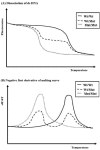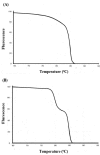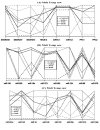Role of Melt Curve Analysis in Interpretation of Nutrigenomics' MicroRNA Expression Data
- PMID: 29109097
- PMCID: PMC6070330
- DOI: 10.21873/cgp.20057
Role of Melt Curve Analysis in Interpretation of Nutrigenomics' MicroRNA Expression Data
Abstract
This article illustrates the importance of melt curve analysis (MCA) in interpretation of mild nutrogenomic micro(mi)RNA expression data, by measuring the magnitude of the expression of key miRNA molecules in stool of healthy human adults as molecular markers, following the intake of Pomegranate juice (PGJ), functional fermented sobya (FS), rich in potential probiotic lactobacilli, or their combination. Total small RNA was isolated from stool of 25 volunteers before and following a three-week dietary intervention trial. Expression of 88 miRNA genes was evaluated using Qiagen's 96 well plate RT2 miRNA qPCR arrays. Employing parallel coordinates plots, there was no observed significant separation for the gene expression (Cq) values, using Roche 480® PCR LightCycler instrument used in this study, and none of the miRNAs showed significant statistical expression after controlling for the false discovery rate. On the other hand, melting temperature profiles produced during PCR amplification run, found seven significant genes (miR-184, miR-203, miR-373, miR-124, miR-96, miR-373 and miR-301a), which separated candidate miRNAs that could function as novel molecular markers of relevance to oxidative stress and immunoglobulin function, for the intake of polyphenol (PP)-rich, functional fermented foods rich in lactobacilli (FS), or their combination. We elaborate on these data, and present a detailed review on use of melt curves for analyzing nutigenomic miRNA expression data, which initially appear to show no significant expressions, but are actually more subtle than this simplistic view, necessitating the understanding of the role of MCA for a comprehensive understanding of what the collective expression and MCA data collectively imply.
Keywords: Biomarkers; DNA; PCR; RNA; SNPs; fermented sobya; food; miRNA; nutrigenomics; pomegranate.
Copyright© 2017, International Institute of Anticancer Research (Dr. George J. Delinasios), All rights reserved.
Figures






Similar articles
-
Three week dietary intervention using apricots, pomegranate juice or/and fermented sour sobya and impact on biomarkers of antioxidative activity, oxidative stress and erythrocytic glutathione transferase activity among adults.Nutr J. 2016 May 12;15(1):52. doi: 10.1186/s12937-016-0173-x. Nutr J. 2016. PMID: 27175476 Free PMC article. Clinical Trial.
-
Diagnostic microRNA markers to screen for sporadic human colon cancer in stool: I. Proof of principle.Cancer Genomics Proteomics. 2013 May-Jun;10(3):93-113. Cancer Genomics Proteomics. 2013. PMID: 23741026
-
A nutrigenomics approach for the study of anti-aging interventions: olive oil phenols and the modulation of gene and microRNA expression profiles in mouse brain.Eur J Nutr. 2017 Mar;56(2):865-877. doi: 10.1007/s00394-015-1134-4. Epub 2015 Dec 22. Eur J Nutr. 2017. PMID: 26695409
-
Variability in microRNA recovery from plasma: Comparison of five commercial kits.Anal Biochem. 2015 Nov 1;488:28-35. doi: 10.1016/j.ab.2015.07.018. Epub 2015 Aug 10. Anal Biochem. 2015. PMID: 26271186
-
Genome-wide microRNA expression profiling in idiopathic non-obstructive azoospermia: significant up-regulation of miR-141, miR-429 and miR-7-1-3p.Hum Reprod. 2013 Jul;28(7):1827-36. doi: 10.1093/humrep/det099. Epub 2013 Apr 4. Hum Reprod. 2013. PMID: 23559187
Cited by
-
Transcriptomic in silico analysis of bovine Escherichia coli mastitis highlights its immune-related expressed genes as an effective biomarker.J Genet Eng Biotechnol. 2021 Oct 12;19(1):153. doi: 10.1186/s43141-021-00235-x. J Genet Eng Biotechnol. 2021. PMID: 34637035 Free PMC article.
-
Mixed lineage kinase domain-like pseudokinase-mediated necroptosis aggravates periodontitis progression.J Mol Med (Berl). 2022 Jan;100(1):77-86. doi: 10.1007/s00109-021-02126-7. Epub 2021 Oct 13. J Mol Med (Berl). 2022. PMID: 34647144
-
Ultrasound-Assisted Extraction Optimization of Proanthocyanidins from Kiwi (Actinidia chinensis) Leaves and Evaluation of Its Antioxidant Activity.Antioxidants (Basel). 2021 Aug 21;10(8):1317. doi: 10.3390/antiox10081317. Antioxidants (Basel). 2021. PMID: 34439565 Free PMC article.
-
miR-96 Inhibits SV2C to Promote Depression-Like Behavior and Memory Disorders in Mice.Front Behav Neurosci. 2021 Mar 19;14:575345. doi: 10.3389/fnbeh.2020.575345. eCollection 2020. Front Behav Neurosci. 2021. PMID: 33815074 Free PMC article.
-
The Antioxidant Phytochemical Schisandrin A Promotes Neural Cell Proliferation and Differentiation after Ischemic Brain Injury.Molecules. 2021 Dec 9;26(24):7466. doi: 10.3390/molecules26247466. Molecules. 2021. PMID: 34946548 Free PMC article.
References
-
- Ahmed FE, Vos P, James S, Lysle DT, Allison RR, Flake G, Sinar DR, Naziri W, Marcuard SP, Pennington R. Transcriptomic molecular markers for screening human colon cancer in stool and tissue. Cancer Genomics Proteomics. 2007;4:1–20. - PubMed
-
- Lee RC, Feinbaum RL, Ambros V. The C. elegans heterochronic gene lin-4 encodes a small RNAs with antisense complimentarity to lin-14. Cell. 1993;75:843–854. - PubMed
-
- Lund E, Dahlberg JE. Substrate selectivity of exportin 5 and Dicer in the biogenesis of microRNAs. Cold Spring Harb Symp Quant Biol. 2006;71:59–66. - PubMed
-
- Lim LP, Lau NC, Garrett-Engele P, Grimson A, Schelter JM, Castle J, Bartel DP, Linsley PS, Johnson JM. Microarray analysis shows that some microRNAs down-regulate large numbers of target mRNAs. Nature. 2005;433:769–773. - PubMed
Publication types
MeSH terms
Substances
LinkOut - more resources
Full Text Sources
Other Literature Sources
Miscellaneous
